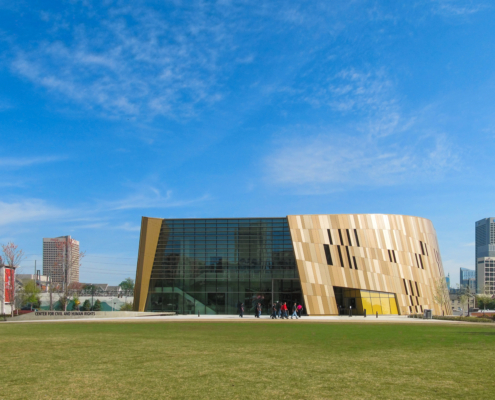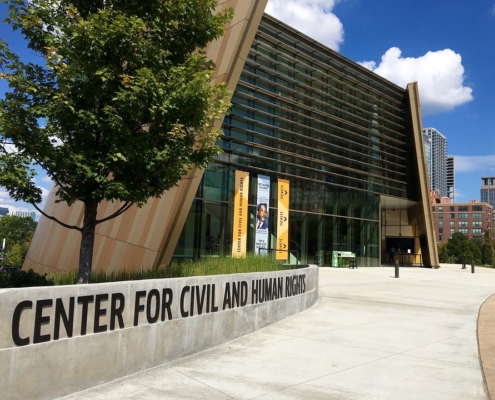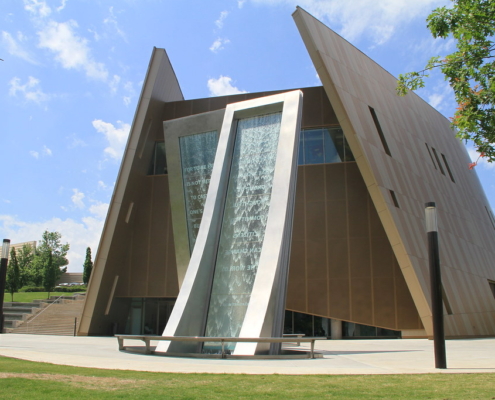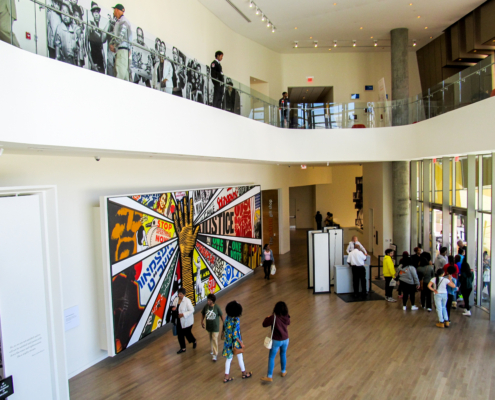Center For Human and Civil Rights
Phil Freelon | Website | 2014 | Visitor Information
100 Ivan Allen Jr Blvd NW, Atlanta 30313, United States of America
"
The design of the National Center for Civil and Human Rights is driven by the concept of creating a Space for Action. The design is inspired by great urban spaces from around the world that are synonymous with historic civil and human rights events: the National Mall in Washington, Tiananmen Square in Beijing and Tahrir Square in Cairo. The iconic form of the Center is defined by two bold, curving walls. These powerful walls create and define the Space for Action where the Center and its various programs and interactive exhibits remind us of civil rights accomplishments and make us aware of current, global human rights issues. The Center’s design is inspired by the links that connect and empower individuals and groups of seemingly divergent interests to find common ground. Located adjacent to the World of Coca-Cola and the Georgia Aquarium in downtown Atlanta, The Center’s spacious plazas welcome pedestrians from all directions. With almost 30 feet of elevation change, the design offers at-grade entrances on two building levels. The lower level entrance opens onto a generous plaza at Ivan Allen Jr. Boulevard that features an elegant glass and steel water sculpture celebrating civil and human rights. The upper-level plaza faces Pemberton Place, an elliptical pedestrian park that links The Center to other major Atlanta cultural venues. A grand exterior stair wraps the building’s east side connecting the upper and lower plazas. The stairway and terraced landscape overlook an area planted with indigenous grasses intermingled with native shade trees. Within the curved exterior walls, The Center's building program is configured to connect visitors to each other, the important stories of the Civil Rights movement in the US and current human rights issues throughout the world. The 42,000 square foot building program is arranged on three levels with gallery and event space on each. The exhibit designer is New York-based Rockwell Group. The lower level features the special gallery dedicated to the Morehouse College Martin Luther King, Jr. collection and a large multi-purpose room overlooking the lower plaza. A monumental stair connects the lower level to the main lobby above. An array of east-facing windows along this path brings daylight deep into the building. Visitors access the primary building entrance and lobby from Pemberton Place – on the middle floor of the three story structure. From this lobby, one can enter the Civil Rights exhibit and galleries. A stairway leads visitors up to a sweeping balcony overlooking the lobby, Centennial Olympic Park and downtown Atlanta beyond. Both the Civil Rights and Human Rights exhibits culminate on the upper floor in a gallery of shared accomplishments that opens to the balcony and lounge. Reflecting the diversity of humanity, the two curving walls that define the building’s form are clad in architectural panels of varying size and earth tones. A green roof features an extensive planting system that contributes to the sustainable design. Together, The Center's architecture and exhibits become a true Space for Action and create an experience that inspires each visitor through recognition of our shared history and the role we all play in supporting civil and human rights.
"
Information provided in part by: ArchDaily







